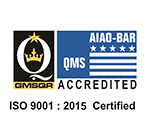A Guide to Attract and Retain Top Talents in Manufacturing Industry

In the modern “war of talent” talent shortage can begin to plague the organization, HR professionals and recruiters all across the world and no industry feel this harder than the manufacturing industry. As per the reports of manufacturing institute and Deloitte, around 22% of the skilled manufacturing workers will require to enter this industry in the coming 10 years.
One of the major challenges that the manufacturing industry faces is the shortage of skilled labor. With boomers leaving the workforce and growing the skill gap for generations Y and Z, the opportunities and the challenges both grows each day. Fortunately, the industry has to maintain and provide solutions to the labor shortage in organizations.

As technology plays a vital role in advanced manufacturing processes, the experience workers are eligible for retirements to start to leave the workforce gap to grow. The companies who can attract, develop and retain skilled workers may have competitive benefits in the marketplace which rewards efficiency, nimbleness and rapid turnaround times.
As per the reports, it has been estimated that around 49% of the tasks people are paid to do in the global economy and have the potential to become automated. The significant shifts which are taking place in the manufacturing industry are affecting not just the way people are working in the organization, but also the skills that today’s worker's need to have.
Major ways to attract and retain Talent
Below are the major ways that can attract and retain the top talent in the manufacturing industry as:

-
Get creative and candidate search
Some of the major issues that business owners usually face when they are looking for the right manufacturing talent may stem from focusing too heavily in their industry or verticals. Not invented here syndrome, this can prevent many of the employers from looking for the talent outside of their industry and thinking that the only experience which matters the most if the direct industry experience.
While the direct experience is an industry is quite valuable and trustable, there is a lot more experience from other industries which can translate well with the proper guidance. When bringing in new employees, you should look to pivot their existing skills into your industry. Adjusting their focus is much convenient and takes a fewer amount of time than building new skills from scratch.
-
Build out Skills Pipeline
Reliable resources can help you with your temporary and permanent jobs opening. You must find the perfect light industrial or machine operator that meets your high standards. Another perception which is required to be shifted is the value of trade skills. There are many organizations that target students at trade schools, trying to bring them to a certain industry.
However, young workers in the trade school have already decided that path, the challenge lies in attracting more people to the skills-based trades. Many of the millennial have seen a lack of career development in the field of manufacturing industry and they can pass invaluable knowledge while staying with your organization longer as an invaluable resource.
-
Overcome Public Perception
For many of the younger workers to enter the workforce, working in the manufacturing industry can lead to carrying a perception problem. They fear the lower status sigma and the reputation for layoffs even though it may not be true. The manufacturers must look to overcome those rumors by investing in other crucial areas to make their jobs more attractive for the future workforce.
Things like working condition and the benefits will go long way with the generation. When you compare the satisfaction level of your workers then you will find many workers on the floor may feel forgotten. It happens many times, that millennial will leave high paying jobs, due to the benefits were not what they were looking for.

-
Compensate fairly
In such a competitive market, offering the market competitive salary for every job is imperative for the organization that hopes to attract and retain top talents. Pay good hikes to each candidates so that they can remain with your organization for longer periods. Never forget that the employees are the basic element of your organization. So, never disappoint them and their talent at the cost of salary.
-
Implement training programs
It is crucial to develop workers that you have already by moving them up in the ranks. Promotions and progress help to build morale and increase the employee's engagement and retention as well. As an older worker approach retirement, the manufacturers must create knowledge transfer and mentoring programs to involve them in training the next generation to avoid facing a massive skill gap. You must offer them time to time training session for increasing their learning abilities and knowledge.
Reasons for the Worker’s Shortage in Manufacturing Industry
What most of the workers do not realize is that there is a wide range of salaries for those in the manufacturing industry. While some manufacturing professionals earn as low as $25786 for floor assembles, many of the salaries can increase to as high as $142593 for roles like industrial engineer manager. In truth, there is room for upward mobility and compensatory growth in each sector. So, what is the reason behind the shortage of workers in the manufacturing industry?
-
The retirement of Baby Boomers
The manufacturing skills gap continues to grow, as experienced workers eligible for retirement begin their exodus from the workforce.
-
Millennial Disinterest
It is no secret that millennial are moving away from the blue collar jobs in the favor of cozier desk jobs in the science, technology, engineering, and other fields. In the world with rapidly evolving technology, millennial may also be excited to enter a field where their job has the potential to become automated or disappear altogether.
-
Weak manufacturing training programs
A lack of proper training, especially safety training leads to the revolving door of workers that do not last longer than six months to the year because of injuries or general dissatisfaction.

-
Knowledge gap
These days, manufacturing workers tend to be either baby Boomer versions of the newcomers fresh out of the schools. As the Gen X generation who should be in management came of the age when parents and teachers were steering kids away from what appear to be decorrelating the industry.
-
Drug testing
Strict drug testing requirements sometimes determine the potential applicants and that is not toasted these regulations should not be in the place. But, it is a quite discouraging factor for some who are thinking of entering into the industry as it could be viewed as an invasion of privacy.
-
Failing to provide success path
One of the best indicators for future success is the organization's ability to have the employee's climax ladder of jobs with progressively more responsibility. There are many workers who are entering the manufacturing sector and want to find the position which clearly marketed the path towards career advancement.
[Also Read: How to retain employees in the company]
Conclusion
Proactively attracting to the right qualified talent and investing in ongoing training and development program can help to keep workers engaged, encouraged the retention of skilled employees and prepare manufacturers to more productive and more competitive in the marketplace.
Recent Blog

Why Your Business Needs a Mobile App?
06-Dec-2022Related Blogs

Strategies for Virtual Staffing
07-May-2018
Major Benefits of Virtual Staffing
10-May-2018
A Brief Introduction to Recruitment process
29-Jun-2018
What is Change Management Process
19-Jul-2018
How to Improve Your Recruitment Process
01-Aug-2018









